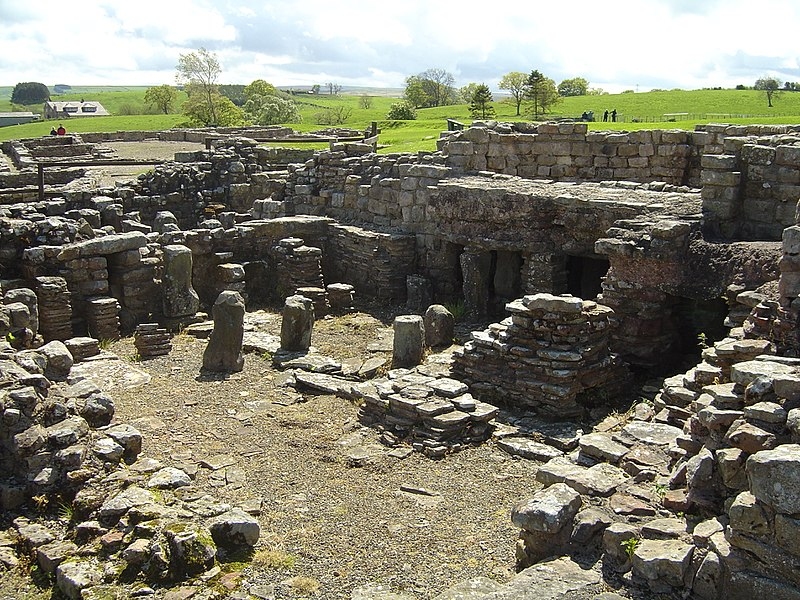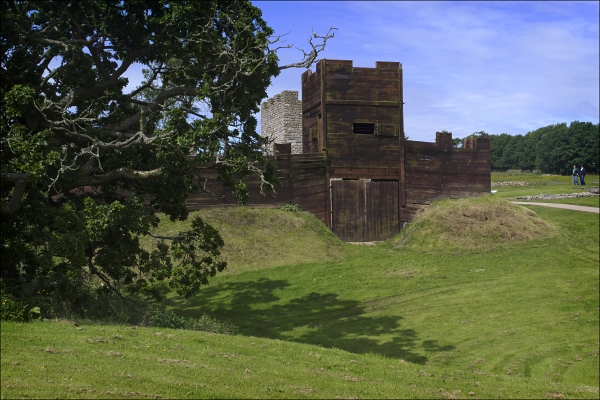
We arrive at Vindolanda in early afternoon and join the many visitors who are enjoying this glorious summer Sunday wandering around the ruins. Vindolanda was a Roman outpost fort of immense dimension and great effort has been taken here to not only preserve the remains, but to give visitors a glimpse of life as it existed on the frontier just north of the wall.
Walking the graveled paths between bath houses, living quarters and garrison dormitories it's easy to get an idea of the layout of the stronghold. Vindolanda means "bright heath", an appropriate name as it lies in vast open fields, which today are blanketed with buttercups.
There is a museum here with an incredible display of well preserved artifacts. One glass case holds hundreds of shoes, making me wonder aloud if some sort of bizarre shoe graveyard has been unearthed. The leather looks to be about fifty years old, not 1500, and I am still puzzled, even after reading as much as I can get my hands on, as to the environmental conditions that aided in preserving this natural material so exquisitely.
Another case features fragments of glass which impress me, not only the color which was a surprisingly vivid blue-green, but that the bottles have smooth rounded lip rings similar to our Coca-Cola bottles of the mid-20th century.
One terra cotta pot, covered with intricate designs of vines and flowers has been preserved in pristine condition. It looks as if it could have been purchased for my patio just last week. Weapons, tools, armor, riding tack and household implements are all here – an incredible and impressive collection of artifacts.
Outside of the museum, which is situated beside a stream bordered by a copse of woods, are several replica rooms, including a market and living quarters. These are Disney-esque with wax figures and plastic foodstuffs, but very educational.
We leave the museum and head back up the hill. I smile, thinking to myself that everything I want to see seems to be up a hill, but I am developing a long even stride that carries me much further than I ever would have imagined I could walk in one day.
Beyond the ruins we spy a group of people laboring away with shovels and wheeled barrows down inside an excavation. Among this group is archaeologist Robin Birley, who kneels with trowel and brush, carefully and methodically uncovering a newly discovered bath house. It is a joy and a privilege to stand and watch him embrace his passion for a few moments before we head back to the car.

Vindolanda was a Roman auxiliary fort just south of Hadrian's Wall in northern England. Archaeological excavations of the site show it was under Roman occupation from roughly 85 AD to 370 AD.
Located near the modern village of Bardon Mill in Northumberland, it guarded the Stanegate, the Roman road from the River Tyne to the Solway Firth.
It is noted for the Vindolanda tablets, a set of wooden leaf-tablets that were, at the time of their discovery, the oldest surviving handwritten documents in Britain.
The Vindolanda site museum, also known as Chesterholm Museum, conserves and displays finds from the site. The museum is set in gardens, which include full-sized reconstructions of a Roman temple, a Roman shop, a Roman house and Northumbrian croft.
Read more about Vindolanda at Wikipedia.